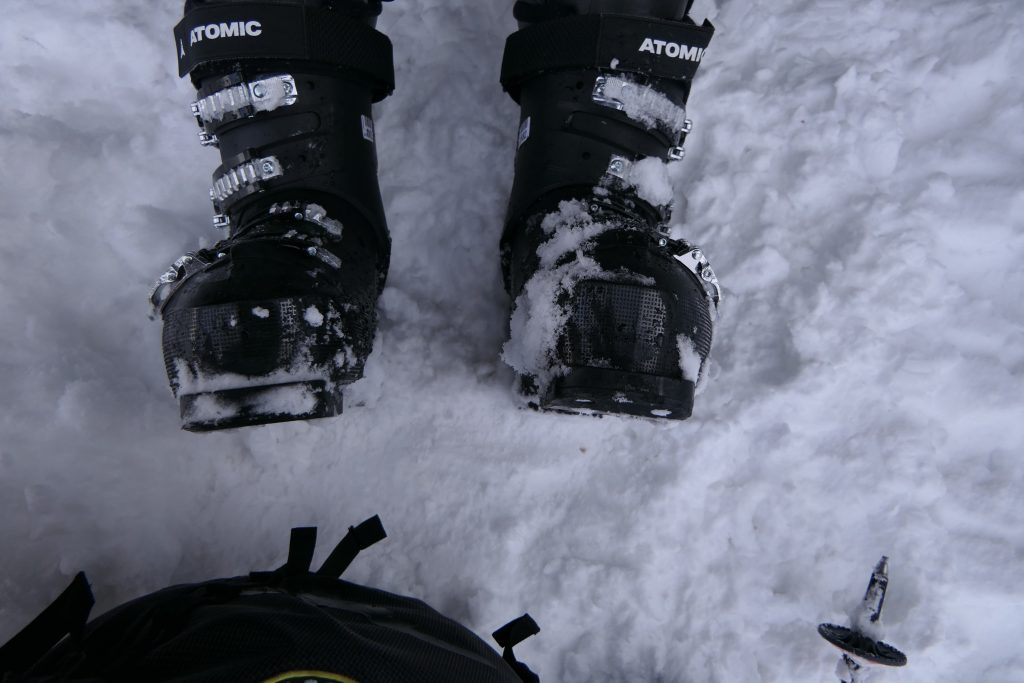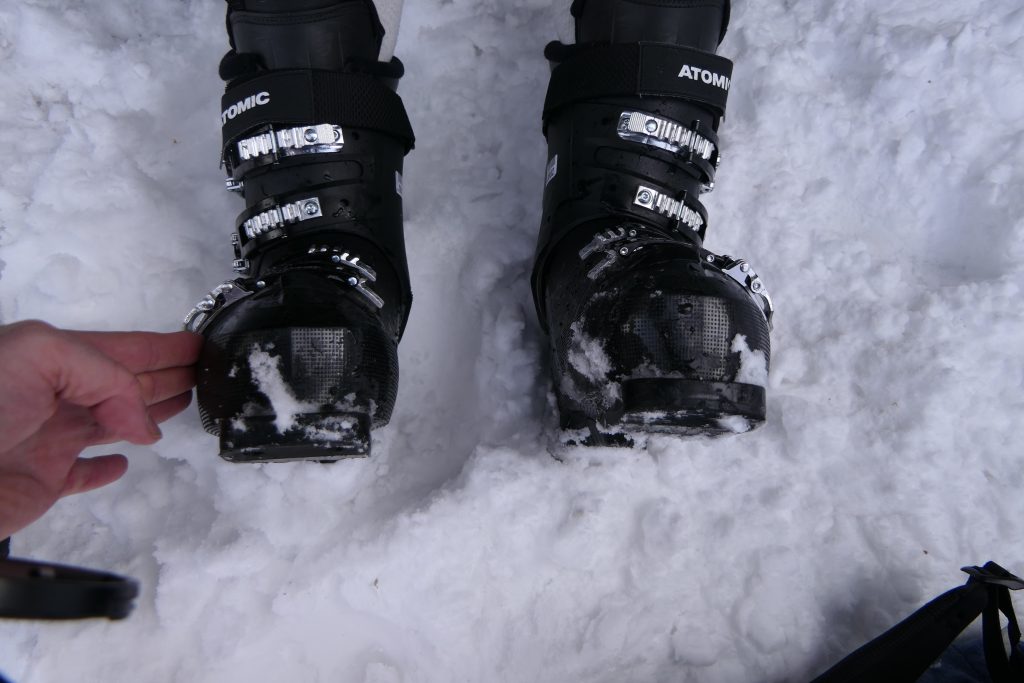First video shows heel pushing (outwards) due to lack of dynamics and an effort to keep the body facing downhill.
Second video shows dynamics beginning to shape a rounder, more solid and controlled turn. This was filmed prior to working on hip angulation.
- Skating
- Dynamics
- Sideslip
- Pivot
- Combining Dynamics and Pivot
- Hip Angulation
- Ski Boot Alignment
Skating/Adductors
Skiing is just disguised skating. The main difference is the skis are wide and have two edges. When diverging the skis outwards at the tips into a skating stance the skis want to flatten on the snow and the stiff shaft of the ski boots will pull the knees outward. The adductor muscles need to be engaged to hold the skis on their inside edges. This is a pattern of muscle use – the adductors of both legs contracting – that should be maintained when skiing parallel. This is partly dependent on the skier’s morphology. If the femurs are naturally directed inwards less adductor use might be appropriate but if slightly bow legged there may be a need to consciously work the adductors.
Only when snowplough braking should the adductors be released to widen the spreading of the tails of the skis from the hip joints.
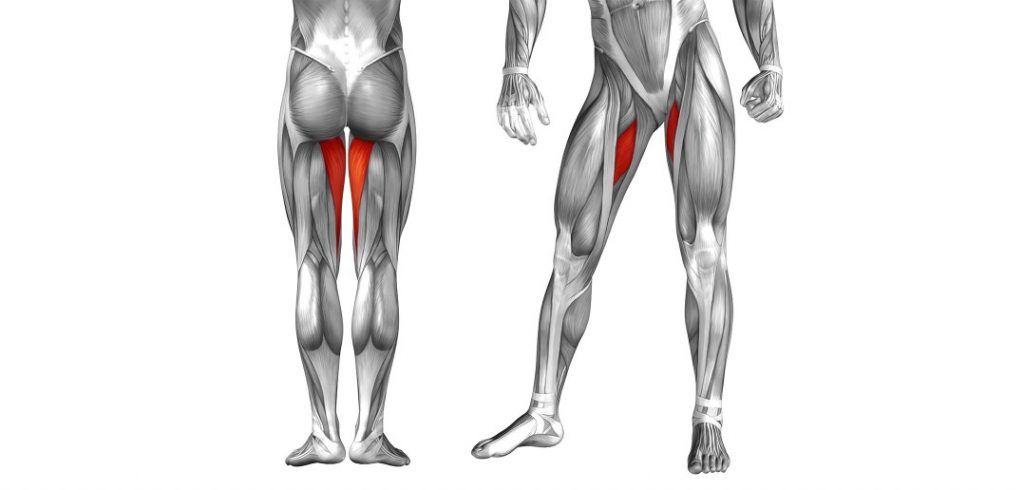
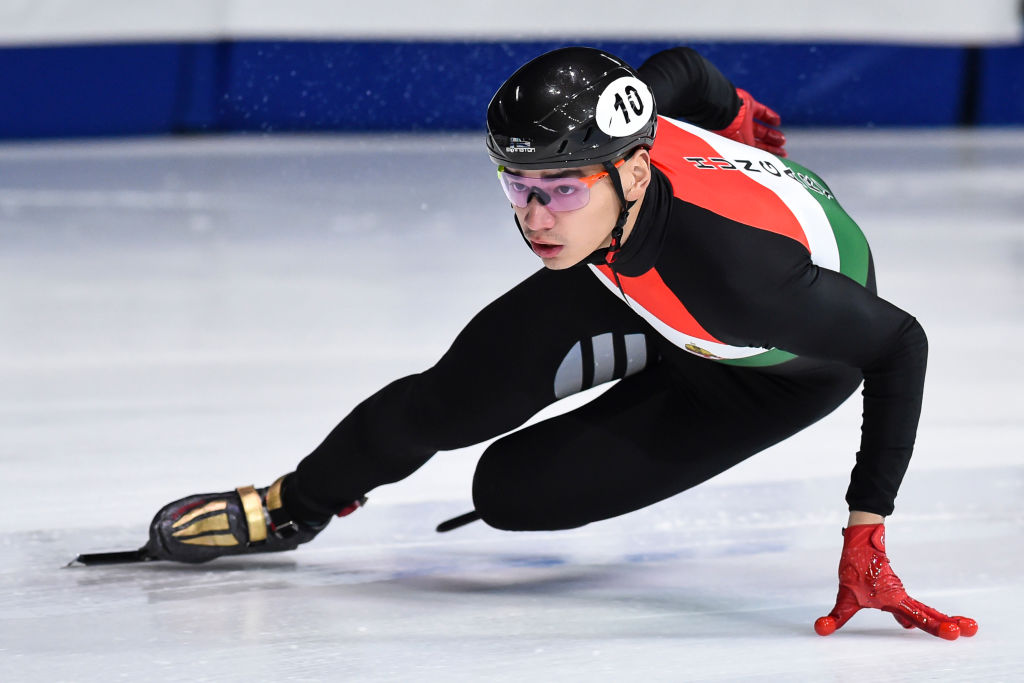
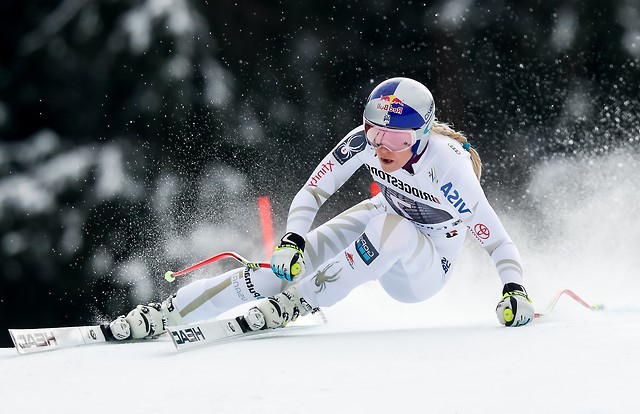
The other difference between skis and skates: – it’s just that skis bend and scribe arcs on the ground and are generally used on slopes not flat lakes. Skating actions are fundamental for a skier’s development because they involve independent leg action where only one leg at a time is really used. Although skiers can stand on two feet the body is oriented specifically on one hip joint at a time (when turning) and has to function as if standing on one leg. Skating exercises such as skating step turns are helpful in developing basic skills. Skating turns use diverging skis (opposite from snowplough) and incremental stepping of the centre of mass inward toward the turn centre. This is ideally the first sort of turning that any complete beginner should experience – on flat terrain.
Basic Dynamics (skis parallel)
- Skis must be travelling forward – like a bicycle
- This is mainly about using the outside leg (start of new turn) to push the centre of mass into the centre of the new turn – for the whole duration of the turn
- There is no “balance” when skiing – dynamics is the physics of disequilibrium
- You are looking for stability from organised accelerations (ski technology!)
- Notice in the photos below the outside leg is essentially straight in a skating action (flexion for absorption and other purposes is primarily at the hip joint)
- The centre of mass goes down toward the snow – and to complete the turn it comes back up – like a motorbike in a turn
- There is no “Centrifugal Force” acting on the skier – only a deflection inward away from a straight line. This deflection is used to lift the skier up at the end of the turn – which involves “finishing” the turn – I.E. turning almost back up the hill.
- Remain square to the skis (follow the skis around the turn with your body) until you are really comfortable with movement of the centre of mass and clearly aware of moving it.
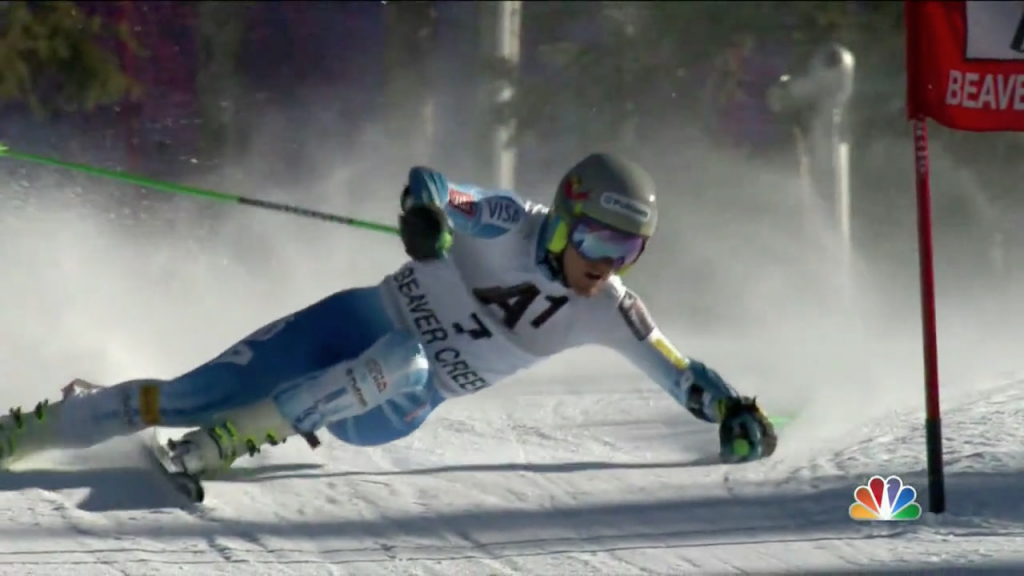
Side Slipping (Centre of Mass)
The main practical purpose of sideslipping is to get down the mountain without picking up speed. Many learners are deprived of this skill because it is generally undervalued and has become even more neglected due to the complete domination of carving skis. Wider skis are easier for sideslipping in a greater range of conditions. Parabolic skis have some trouble gripping on ice during a sideslip, but modern “double rocker” off-piste skis give a smooth and grippy sideslip in just about every condition, including ice.
The skis are kept on edge by the lateral stiffness of the ski boot shafts. Skis over 100mm wide underfoot begin to create problems on hard snow due to the extra leverage from the edge through the shaft of the boot. Those skis can be very unpleasant on-piste and it’s one limit of how an “all round” ski can be defined. Anything wider than 100mm is not “all round”. In ski teaching the sideslip serves specifically for developing fall-line skiing. Fall-line skiing is where the skier’s body travels directly downhill and not across the hill. This would apply to bumps, steep off-piste such as couloirs and deep powder snow. Slalom is not “fall-line” skiing. The skier should be able to sideslip on either ski or both at the same time. It’s normal to start off with both skis on the snow, skis parallel and with the majority of weight on the lower ski just to get a feel for it. The stance is normally quite narrow to prevent the uphill ski from catching the lower edge. Most beginners have trouble keeping the skis close together.
It should be noticed that only the uphill edges of the skis are in contact with the snow so the downhill edges are in the air. If the fronts of the skis are pushed downhill (Joystick Control – moving the Centre of Mass forward) then there will be no resistance from the downhill edges and so the skier goes into a forward diagonal sideslip. Likewise if the tails are pushed downwards during the sideslip then it turns into a backwards diagonal sideslip. Being able to alternate between straight down the fall-line and the two diagonals is a precursor to the skill necessary for pivoting in the fall-line. Both legs need to squeeze the adductor muscles together – holding the upper legs close together. Pulling both legs together keeps a narrow stance and when the skier practices sideslipping on one leg it ensures the that the geometry of the edge angles to the slope are optimum for pivoting.
Pivot (Skis sliding Sideways)
Pivoting is derived from the skis sliding sideways and can be developed from side slipping (It’s a braking form of turning). With a “pure pivot” as an exercise there is no forward travelling of the ski across the hill. Support for the centre of mass is now provided by support from a downhill pole plant. This is the real reason why we have ski poles! There is a full dedicated explanation of pivoting at the following link: “PIVOT“
Combining Dynamics and Pivot
- Dynamics depends of forward motion of the skis and lateral falling/pushing of the centre of mass
- Pivot depends on lateral motion of the skis – but always with the centre of mass being driven inward (toward the turn centre) modulated by the support of a pole plant
- The two can be combined – when there is both forward and lateral motion – making overall control of trajectory and speed totally under control of the skier
- In all cases there must be active adductor muscle use – and the feet must be “everted” i.e. turned outward inside the ski boots – diverging sightly (skating stance)
- The essential element to take from combining pivot and dynamics is to execute the turn transition from the uphill edge of the uphill ski – noting that the ski enters the new turn more easily than when on its inside edge and this also prevents stemming (and body rotation)
- Additionally with the transition between the two turns being made from the uphill edge it’s easy to switch into a very tight pivot when desired
Look at the skis in the two images below. The top image is with skis carving – the bottom image skis pivoting
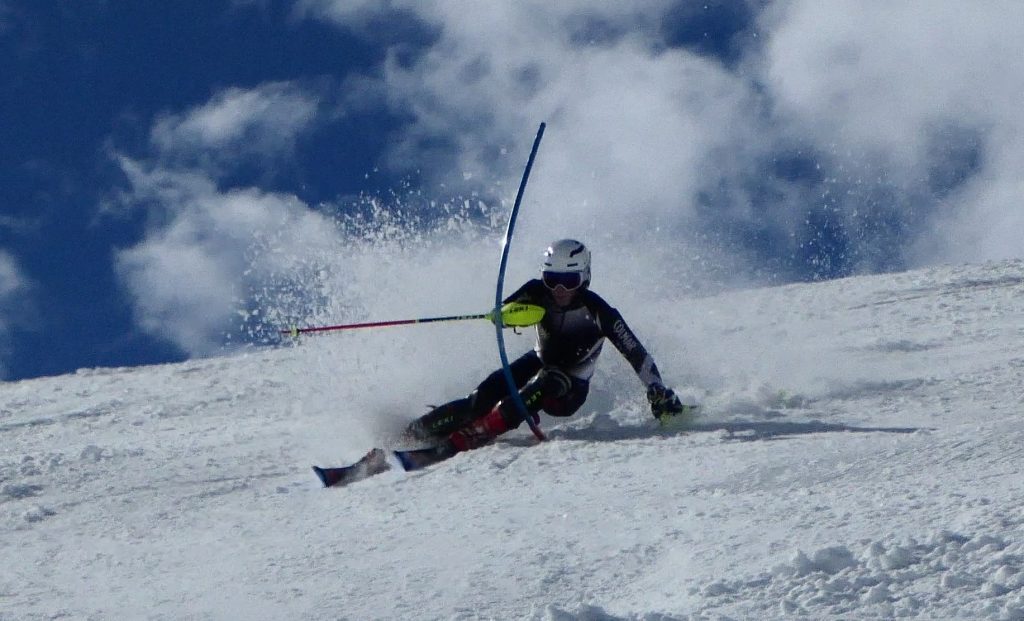

Body Management (Hip Angulation)
Take a look at the two Olympic champion skiers in the photograph below.
Killy’s image from the 1960s has his chest facing downhill whereas Noel’s image from 2022 has his chest facing forward. What Killy is doing destroys your lower back and is probably why he never went on skis again after he stopped racing.

Protecting the Spine
- Hold the front of the pelvis up – aiming for “neutral pelvis”
- During the turn pull the outer hip backwards so that the ski doesn’t pull it in front of your ribs
- Look for a stretch between the ribs and hip joint
- Look for a reflex contraction of the lower abdominals – the postural reflex
- Keep the shoulders/chest following the skis (to some degree)
- Always “counter turn” the pelvis more than the chest/shoulders (It’s only the pelvis that should “face downhill”)
- Pulling the hip backwards also prevents both hip rotation and full upper body rotation
Source of Hip Angulation
The upper body needs to tilt forward over one hip joint – then rotate around it. This is in addition to pulling back the outside hip etc.
The body shape produced alters the location of the centre of mass enabling pressure on the ski fronts and also greater agility both into and out of turns – and pole planting if the skis are swinging laterally.
The hip angulation also provides flexion of the hip joint that gives absorption of shocks. Increased angulation also increases the edge angle of the skis to the snow and may alter the turn radius and grip.
Angulation when upright and pivoting has another function – when ANTICIPATING the next turn it is used to get the Centre of Mass out of the existing turn (by tilting the torso forward at the hip ) and letting the Centre of Mass move over the skis to plant the ski pole downhill for a strong, clear and definite support.
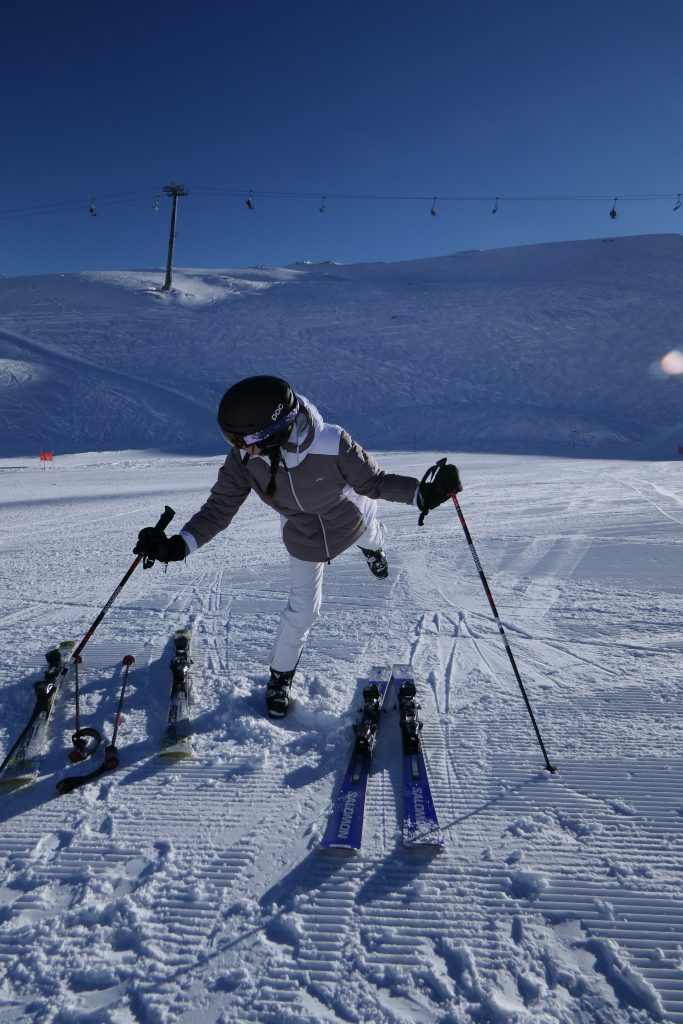
When the entire body inclines into the turn with hip angulation present this below is what it looks like.

Ski Boot Alignment
Good quality ski boots have the ability to adjust the angle of the shafts laterally so that they can conform accurately with the skier’s morphology.
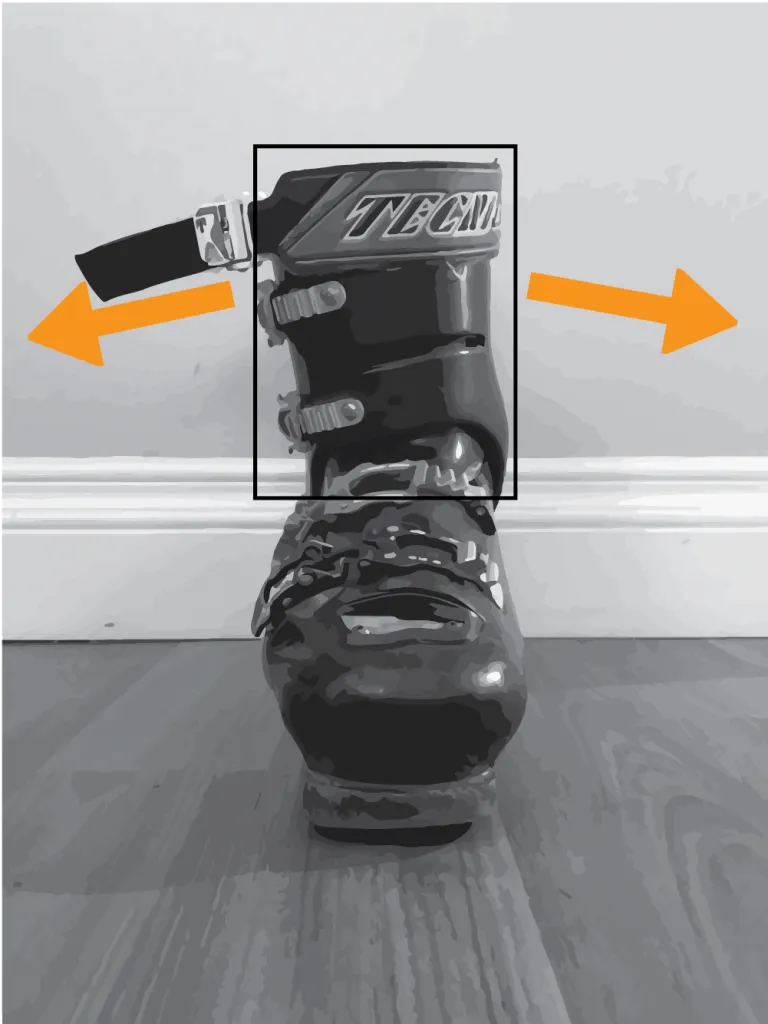
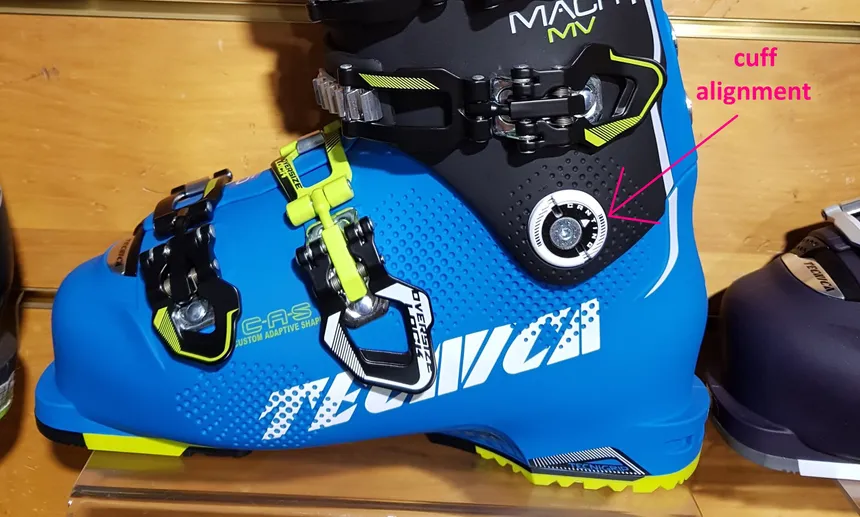
Shops always have you standing in the boots and bending the ankles, knees and hips to assess whether or not alignment is correct. Sometimes they even prepare supportive footbeds to be added and have special contraptions that you can stand on – but the approach is completely wrong (most of the time).
Around 1995 I figured out the right way to align – it’s done sitting on the edge of a bench/chair with the legs completely straight out in front (knee joints must be totally straight) – no weight on them – feet hip width apart (parallel) – toes vertically aligned (not with the toes rolled inward or outward) and hip joint flexed with the lower back straight and upright. The soles of the boots when correctly aligned are flat.
The left image shows boots that need the cuffs canted toward the outside so the soles can be flat. If there is no canting mechanism or appropriate tool available then cutting cardboard or plastic shims to insert on the inner side of the shaft between the shell and the inner boot will have the same canting effect (this was done with the boots below as a temporary measure). The skier previously had trouble gripping with the inner edges when skating and had developed a very wide stance to compensate for the lack of edge grip and response. Sometimes people (often women) can have the opposite problem with the ski boot too much on edge – so canting the shaft inwards is necessary instead.
